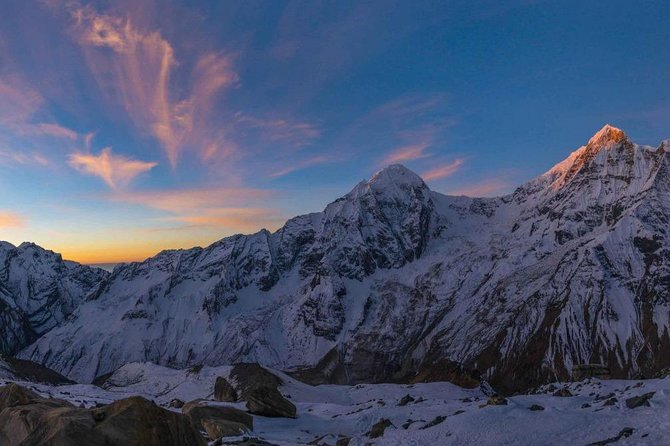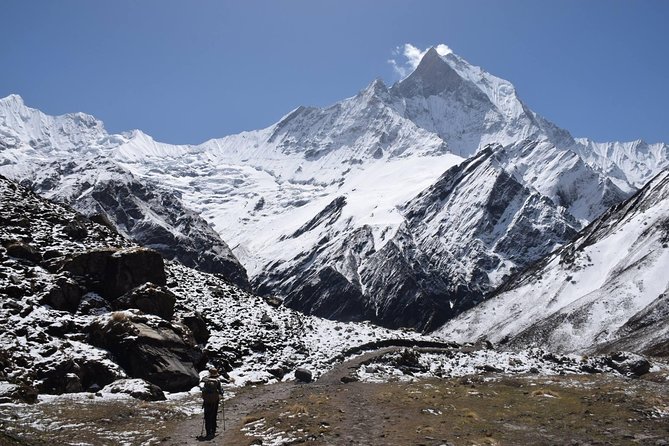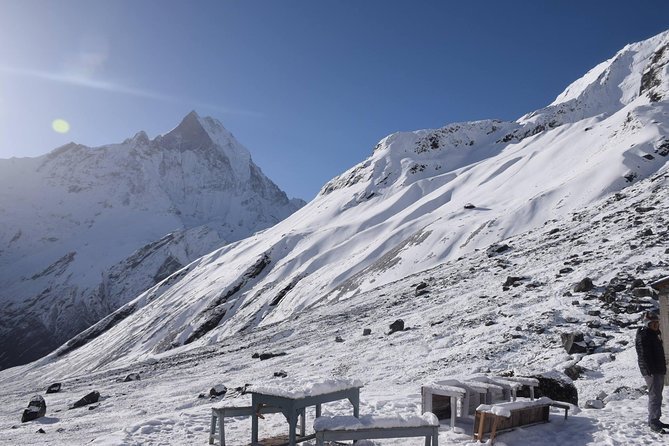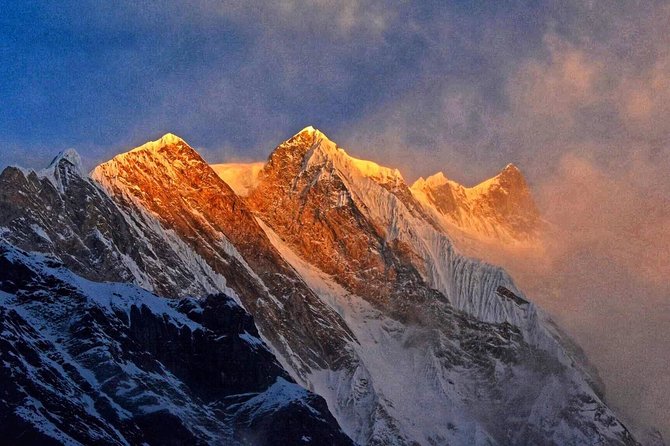Annapurna Base Camp Trekking
Nestled amidst the towering peaks of the Annapurna region lies a trekking experience that juxtaposes rugged adventure with serene beauty.
The Annapurna Base Camp Trekking route offers trekkers a chance to enjoy a world where lush forests and diverse wildlife coexist with snow-capped mountains and cascading waterfalls.
As travelers navigate through this picturesque landscape, they will encounter a blend of challenges and rewards that promise an unforgettable journey.
But what makes this trek truly special goes beyond the scenic vistas; it’s the cultural encounters and warm hospitality of local communities that truly set this adventure apart.
Key Points

- Optimal seasons for trekking are spring and fall.
- Essential packing items include proper gear and layers.
- Enjoy stunning views, rich culture, and diverse landscapes.
- Choose between luxury lodges or camping for accommodation options.
Annapurna Base Camp: Overview

Annapurna Base Camp offers trekkers a breathtaking journey through the Himalayas, providing stunning views and a challenging yet rewarding experience.
The weather conditions at Annapurna Base Camp vary depending on the season. In the spring (March to May), the temperatures are mild, and the rhododendrons are in full bloom, creating a vibrant landscape. In contrast, the fall season (September to November) offers clear skies and excellent visibility, perfect for capturing the majestic mountain peaks.
A trek to Annapurna Base Camp also provides a rich local culture experience. Trekkers can interact with the Gurung and Magar communities, learning about their traditions, lifestyle, and enjoying their warm hospitality. This culture adds a unique dimension to the trekking adventure.
Best Time to Trek

For optimal trekking conditions at Annapurna Base Camp, timing your journey to coincide with the spring or fall seasons is recommended to experience mild temperatures, blooming rhododendrons, clear skies, and breathtaking mountain vistas. During these seasons, the weather conditions are generally stable, with less chance of monsoon rains or heavy snowfall that could hinder your trek.
Spring, from March to May, offers pleasant daytime temperatures ideal for trekking, while fall, from September to November, provides crisp air and stunning views after the monsoon season. When preparing for your trek during these times, ensure you have appropriate trekking gear such as sturdy hiking boots, layers of clothing for temperature fluctuations, a good quality backpack, and a reliable sleeping bag to stay comfortable during the journey.
Packing Essentials

Ensuring you pack the right essentials can significantly enhance your experience while trekking to Annapurna Base Camp. When it comes to gear selection, prioritize items like sturdy hiking boots, moisture-wicking clothing, a warm sleeping bag, a reliable tent, and a good quality backpack.
Be prepared for varying weather conditions by packing layers that can be easily added or removed, including a waterproof jacket, gloves, a hat, and sunglasses. The weather in the Annapurna region can change quickly, so it’s essential to be equipped for both sunny days and chilly nights.
Plus, don’t forget to pack essentials like a first aid kit, water purification tablets, high-energy snacks, and a headlamp for navigating in the dark. By carefully selecting your gear and considering the weather conditions, you’ll be well-prepared for your trek to Annapurna Base Camp.
Route Highlights
With breathtaking mountain vistas and diverse landscapes, the route to Annapurna Base Camp showcases a myriad of natural wonders waiting to be explored. Along the journey, trekkers can experience:
-
Scenic viewpoints: Witness stunning panoramic views of the Annapurna mountain range and surrounding valleys.
-
Local culture: Immerse in the rich traditions and hospitality of the Gurung and Magar ethnic communities along the trail.
-
Wildlife sightings: Spot various Himalayan wildlife such as the elusive snow leopard, colorful Himalayan Monal birds, and the playful Himalayan tahr.
-
Trekking challenges: Encounter a mix of terrain including steep ascents, rocky paths, and high altitude conditions that offer a rewarding physical challenge.
Accommodation Options
The journey to Annapurna Base Camp offers a variety of accommodation options that cater to different preferences and budgets along the trail. Trekkers can choose from luxury lodges that provide comfortable beds, hot showers, and delicious meals, offering a more upscale experience amidst the rugged terrain.
For those seeking a more immersive outdoor adventure, camping sites are available at various points along the route, allowing trekkers to spend nights under the starry skies surrounded by the breathtaking Himalayan landscape. These camping sites provide a more rustic experience, where trekkers can bond over campfires and enjoy the simplicity of life in the mountains.
Whether opting for the indulgence of luxury lodges or the charm of camping sites, there’s an accommodation option to suit every trekker’s preference on the Annapurna Base Camp trail.
Food Options on the Trail
For trekkers embarking on the Annapurna Base Camp trail, a diverse array of food options awaits along the journey, adding flavor and sustenance to their adventure amidst the majestic Himalayas. Local cuisine plays a significant role in the food offerings, allowing trekkers to enjoy the flavors of the region. For those with dietary restrictions, many teahouses and lodges along the trail are accommodating and offer vegetarian, vegan, and gluten-free options. Here are some food options you may encounter on the trail:
- Dal Bhat: A traditional Nepali meal consisting of rice, lentil soup, vegetables, and pickles.
- Momos: Delicious dumplings filled with meat or vegetables, served with a spicy dipping sauce.
- Thukpa: A hearty noodle soup with vegetables or meat.
- Yak steak: A unique local delicacy for a protein-packed meal.
Altitude Sickness Prevention
To prevent altitude sickness while trekking to Annapurna Base Camp, trekkers should gradually acclimatize to the increasing elevation. This can be achieved by taking regular breaks and staying hydrated. Altitude acclimatization is crucial in avoiding the potential risks associated with ascending to higher altitudes. It’s recommended to ascend slowly, allowing the body time to adjust to the reduced oxygen levels.
Trekkers should also pay attention to their health by monitoring for symptoms of altitude sickness, such as headaches, nausea, or dizziness. Proper health precautions include maintaining a well-balanced diet, avoiding alcohol, and getting adequate rest. Staying hydrated is essential to help the body cope with the higher altitudes.
Trekking Tips and Recommendations
Embark on your Annapurna Base Camp trek with confidence by following these essential tips and recommendations. Proper preparation is key to a successful trekking experience in the Himalayas. Here are some crucial pointers to keep in mind:
-
Equipment Checklist:
-
Ensure you have sturdy hiking boots, appropriate clothing layers, a good quality backpack, sleeping bag, trekking poles, and a first aid kit.
-
Fitness Preparation:
-
Start a training regimen prior to the trek, focusing on cardiovascular exercises, strength training, and long hikes to build endurance.
-
Stay Hydrated:
-
Drink plenty of water throughout the trek to combat altitude effects and maintain energy levels.
-
Acclimatize Wisely:
-
Ascend gradually, allowing your body time to adjust to the altitude and reduce the risk of altitude sickness.
Common questions
What Is the Level of Difficulty for the Annapurna Base Camp Trekking?
When considering the Annapurna Base Camp trekking, travelers should be aware of the terrain challenges and the importance of acclimatization needs. Weather conditions can vary, necessitating physical preparation for a successful journey.
Are There Any Specific Permits Required for This Trek?
Permit requirements and trekking regulations depend on the specific location and nature of the trek. It’s essential to research and obtain the necessary permits beforehand to ensure a smooth and legal journey.
Is It Possible to Hire a Guide or Porter for the Trek?
Yes, it’s possible to hire a guide or porter for the trek. Guide services offer expertise and navigation assistance, while porter services help carry gear, making the journey more manageable. These services enhance the trekking experience.
Are There Any Emergency Services Available Along the Trekking Route?
Emergency services along trekking routes provide medical assistance and emergency evacuation if needed. They ensure the safety and well-being of trekkers. Knowing these services are available can offer peace of mind during challenging adventures.
Are There Any Cultural or Religious Considerations to Keep in Mind During the Trek?
When trekking, it’s important to respect cultural customs and religious practices. Be mindful of dress codes, behavior in temples, and local traditions. Seek guidance from guides or locals to ensure you honor these aspects appropriately.
Last Words
Embark on the Annapurna Base Camp Trekking adventure to witness the stunning beauty of the Himalayas, learn about the rich culture of the region, and challenge yourself in the midst of breathtaking landscapes.
With the right preparation, gear, and mindset, this journey promises to be an unforgettable experience that will leave you in awe of the natural wonders that Nepal has to offer.
Don’t miss out on this incredible opportunity to explore the Annapurna region!